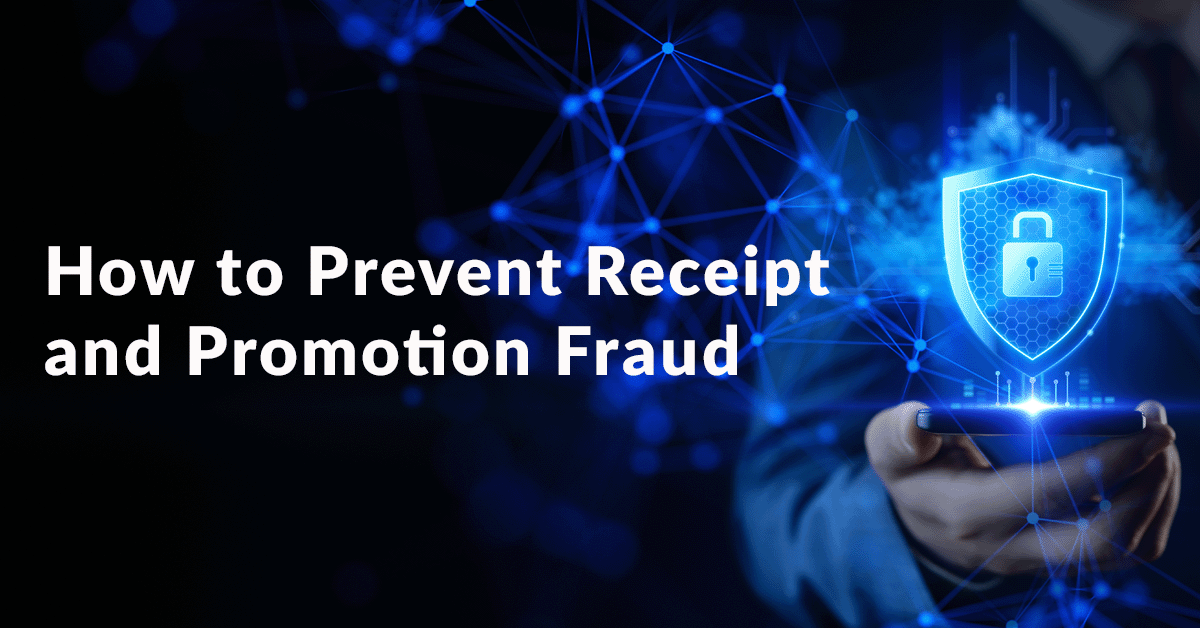Promotions reward customers for their engagement and loyalty, yet fraud has grown into a costly issue for many brands. Manipulated or fabricated receipts, duplicate submissions, and misuse of promo codes can weaken campaign integrity and drain ROI. As fraud tactics become more sophisticated, businesses need stronger tools to protect their programs. Effective prevention relies on automated validation, advanced image and data analysis, and continuous monitoring for unusual behavior. A layered system that checks dates and timestamps, reviews photo metadata, and uses machine learning to flag suspicious patterns gives brands a much stronger defense. This approach not only protects budgets and safeguards campaign results but also reinforces consumer trust by ensuring a fair, secure experience for legitimate participants.
What is Receipt and Promotion Fraud?
Promotion fraud, also known as promotion abuse, is when consumers take advantage of your business offers. They might try to use offers or promotions repeatedly, provide misleading data like fake email addresses, or even use other customers’ promotional codes.
Receipt fraud is when customers steal, duplicate, or falsify receipts. This can happen when information on existing receipts is modified, new, fake receipts are produced, multiple people submit the same or similar receipt, out-of-date submissions, and a variety of other ways (AI tools will only make this easier to do).
Promotion fraud and receipt fraud can have a significant impact on your business. For example, PayPal had to shut down 4.5 million accounts in one year after discovering bad actors had hacked their rewards and loyalty program. Activity like this can be costly for large businesses, where even small financial losses quickly add up to large sums when perpetrated by thousands of fraudsters. So, staying aware of fraudulent receipt and promotion activity is important.
Examples of Receipt and Promotion Fraud
- Receipt fraud: consumers modify information, fabricate images of receipts, make out-of-date submissions, or mislead you by using similar or unqualified product receipts.
- Promotional codes: predictable, simple, and easy-to-guess promotional codes are prime for the picking. Bad actors try to guess codes to secure an offer or discount, even if you haven’t supplied them with a code.
- Action-based promotions: whether it’s a sign-up bonus, free trial reward, or referral discount, it’s easy for people to repeat actions multiple times using fake information to receive rewards.
- Multi-accounting: many businesses restrict customers to a single account. However, some customers will create and use new email addresses to register for more than one account. With this tactic, they can receive and benefit from your promotions multiple times.
- Gift with purchase: bad actors take advantage of promotional gifts and resell them for profit. They might even return their original purchase.
5 Ways To Prevent Receipt and Promotion Fraud
At Snipp, we’re leaders in receipt processing technology and consumer promotions and contest management, so we take anti-fraud measures seriously. We provide expert fraud detection and prevention solutions so you’re always hot on the heels of bad actors. Here are our best practice security measures to reduce the risks of receipt and promotion fraud in your business.
1. Date and Time Stamps
Receipts should include key information like:
- Date
- Time
- Transaction number
- Items
- Item price
- Location of purchase
Using these fields, fraud detection and prevention systems automatically flag incorrect or suspicious data submissions. Or, flag receipts for manual review if a combination of these fields appear on more than one receipt.
2. File Structure
In most cases, customers must submit a photo of the receipt to claim a promotion or reward. At Snipp, our automated receipt technology captures info from the EXIF data within the photo file. If the EXIF data matches, our receipt OCR system moves it into manual review where the matching receipt is displayed.
3. Photo Markers
Customer receipt photo submissions have ‘fingerprints’ within the photo. Fraud and detection prevention systems automatically digitize and compare images across the program's image catalog. If there are any matches, they’re moved into manual review, where the matching receipt is displayed.
4. Statistical Analysis
At Snipp, our automated receipt validation technology flags users whose participation rates are outliers. A higher-than-average level of participation will automatically raise concerns. This person might receive a more significant number of rewards than normal, for example. Once flagged, our system marks all customer submissions for manual validation to help maintain compliance.
5. A Holistic Approach
Finally, using advanced machine learning algorithms, you can manage receipt and promotion fraud at both an activation and validation level across multiple channels. Some examples of these different channels include:
Fraud Detection- Registration Add-ons
- Image Fraud Check
- Fraud Monitoring
- Fraud Prevention
- Address Validation
- Receipt Upload Add-ons
- Industry Standard Bot Detection Applications
- Reward Rules
- 2 Factor Authentication With One Time Password
- Advanced Registration Checks
What Else Should You Look for to Prevent Fraud?
Beyond receipt and activity data, there are softer fraud indicators to look for.
Patterns of behavior can signify receipt and promotion fraud. Fraud detection and prevention systems can recognize these patterns. Algorithms observe specific patterns in any campaign, such as a spike in receipts from a specific retailer. A sudden increase in participation, despite no scheduled marketing event, could indicate fraudulent activity. See details about our fraud and prevention systems here.
The Devil Is In the Detail
Bad actors leave a trail of hidden data in their submissions, email and IP addresses, photographs, and more that are easy to spot with the right tools. At Snipp, we help you uncover this data with leading automated receipt technology – you're risk of financial loss from fraudulent activity remains low. Contact us today to get started with our solutions.
FAQs
What is receipt and promotion fraud?
Receipt and promotion fraud happens when people misuse your offers or rewards programs. They might submit fake or altered receipts, use the same code repeatedly, create multiple accounts, or make false claims to get rewards they shouldn’t.
What types of promotions are most vulnerable to fraud?
Any promotion with a simple entry mechanic can attract abuse, especially receipt-based programs, instant wins, rebates, digital coupons, and refer-a-friend campaigns. Fraudsters often target programs with high-value rewards, long claim windows, or loosely governed rules.
What are the most common ways people fake receipts?
Receipts can be photographed, copied, edited, or reused. Since many programs allow image uploads from any device, fraudsters exploit gaps in validation, such as weak metadata checks or limited duplicate detection. Common tactics include editing totals or product lines in photo-editing apps, stitching together multiple receipts, using screenshots instead of photos, reusing someone else’s receipt, or submitting stock images found online.
What should a brand do if fraud suddenly spikes?
Temporarily slow down fulfillment, tighten rule thresholds, increase manual reviews, block suspicious devices, and review new fraud patterns. Fraud often happens in waves, so rapid intervention matters.
Does fraud prevention require constant updating?
Yes. Fraud tactics evolve, so detection systems must evolve too. Real-time or near-real-time detection is ideal. Early identification helps prevent fraud from snowballing and protects budgets before rewards are fulfilled. Machine learning models should be retrained regularly, fraud rules should be reviewed each campaign cycle, and brands should monitor emerging threats across the industry.






